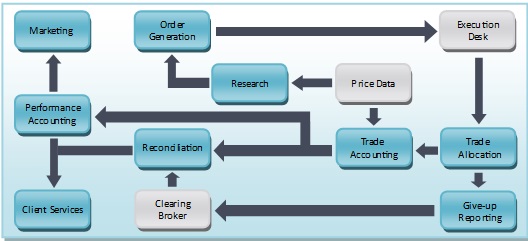Your Backoffice as a Differentiator

The ironic thing about a CTA is they are selling one of the most basic of commodities; Risk Adjusted Returns. There is no difference between a risk adjusted return of 10% from advisor A and a risk adjusted return of 10% from advisor B.
What differentiates advisors are the intangibles such as how clients are handled when the returns are not there.
Having the ability to quickly answer the “Why” and the “What happened” questions; without the need to scramble or better yet, allowing clients to answer these questions themselves using information provided to them automatically or on demand, demonstrates a commitment to the business and to your clients.
From a purely “What’s in it for me” standpoint, an effective back office means an advisor can manage more accounts without more work. Advisors tend to shy away from managed accounts; multiple clearing and executing relationships can quickly require additional staff. An automated back office can easily avoid multiple head counts in even a moderately sized advisor.
Having a solid operating environment means you don’t have to trust that all of your counter-parties got everything right. You can catch errors quicker and get them corrected sooner, before they become your errors.
Finally, an efficient back office means you are able to publish your numbers quicker and more accurately which means you can get paid sooner.
In-House verses Out-Sourced
A basic question for any advisor is whether to perform the back office functions in-house or to out-source them. There are pros and cons to each option, and in practice, most advisors do some of each.
It can be very easy to out-source: select your vendor, sign some papers, and you’re off and running. Depending on what you subscribe to, you may get monthly accounting based on your equity runs, or you may have to provide your trades on a daily basis for reconciliation and NAV calculations.
Because out-sourced solutions are centrally provided, you often have limited options for customization and/or tailoring to your organization. The provider may or may not provide counter-party notification and reporting; and if they do it will typically be for an additional charge. The ability for you to develop customized reports based on the data may also be limited as the data will reside on the supplier’s computer systems, not yours.
Finally, out-sourced solutions can become expensive as they are typically priced as a fee per account or are basis-point based.
In contrast, setting up in-house systems can require significant work on your part. Ignoring the “write it yourself” option, which will take years, setting up a full-blown back office can easily take several weeks. One thing that can be said; it is MUCH easier to set up a system early in your business and then grow than it is to grow and then set up a system. The migration effort can grow exponentially with the number of accounts, especially if you are growing rapidly and attempting to implement a system at the same time.
Because in-house solutions are, by their very nature, in-house, the data resides on your systems. If the package you select does not have the report or capability you want, you can often develop it yourself or have the vendor do it for you.
Regardless of which option you choose, you are going to have some level of trade and position management in-house if you expect to be successful; this somewhat begs the question of why not have an in-house system to begin with?
Typically, established advisors end up with in-house back office systems and out-source their monthly performance reporting. Startups usually begin by out-sourcing, although we are seeing significant interest in systems by new CTAs.
There are two reasons for this: first, newer advisors are more comfortable with technology, and second, there seems to be some supply pressures for back office outsourcing, especially for the smaller accounts. This has come about as more money has flowed into the industry to smaller advisors over the last few years and appears to have eaten away at the capacity at the established outsourcing firms.
Risk Management
To the investor, Risk Management in the context of an advisor’s back office means clearly stated and easily followed operating procedures. In particular, they are interested in early error detection and resolution. For investors in a fund, the addition of transparency is also an issue, especially with new or emerging advisors. In this context, out-sourced back office operations are at a disadvantage because of the inherit delay in the process and the potential for miscommunication.
To the advisor, in addition to ensuring errors are minimized and when they do occur, are caught early; an effective back office system minimizes the risk associated with the key man syndrome so prevalent in small organizations. Not only are procedures documented, they are systematized, allowing operations to be performed by individuals other than the normal person.
In addition, a back office can provide the basis for analytical risk analysis. If you have a full history of trades and the resulting positions in a readily accessible format, what-if scenarios can be applied, actual verses theoretical returns can be analyzed, historic margin utilization can be calculated, as can more sophisticated measures such as Value at Risk.
Finally, your ability to operate when your primary site and/or systems become unavailable is becoming more and more critical. It is safe to say, that in our customer base, even the smallest advisors have some form of off-site backup and many have a remote facility; even if it is simply a backup computer at a principle's residence running a copy of the software and receiving database backups every day. Investors have taken a keen interest in knowing that you have worked through all contingencies in case of disaster, whether the interruption is due to nature or is man-made.
The Back Office as a Marketing Tool
Depending on the sophistication of the investor, they may or may not have the infrastructure in place to turn the standard level of transparency that managed accounts provide into useful information. For those that do not, your ability to provide the information they want, in the format they want, with the frequency they want may be the difference between you getting the allocation and someone else getting it.
Providing daily net asset value reports to your investors, especially during up periods can help minimize the surprises that often occur when people forget to take out the fees when they are simply looking at brokerage statements. A good back office performs all its accounting on a daily basis, ensuring that NAVs include all accrued advisor fees. A side benefit of this is that you can provide daily liquidity if desired.
Being able to offer the types of reports or access to the data, even if it is only used by a small number of clients also demonstrates your firm’s professionalism and commitment to your business.
For example, we provided reporting support for web-enabled cell phones to our product in the summer of 2000. This capability was not used by a single customer until 2003. Now, nearly all of our customers provide access reports using their cell phones. This is particularly important to the advisors who take a shorter term view of the markets. In every case, our customers are emailing reports to investors on a daily and sometimes per-trade basis.
The infusion of institutional funds has resulted in the need to provide data and reports as a condition of the investment. This information feeds the investor’s risk management and performance reporting systems and the trend is moving toward more information being requested.
Finally, depending on the capabilities of your systems, you should be able to extract relevant information from your systems and incorporate it into your presentations and marketing materials.
The Integrated CTA

The Integrated CTA is trading organization where all data used to run the business is contained in a single, server-based database so that applications and users draw upon the same data from anywhere within the network. The vision is a fully integrated information system with knowledge of accounts, trades, prices, positions, and performance. This vision uses paperless interaction amongst all involved and the ability to provide Real-Time performance information to the firm and to the client.
Why is this Important?
Beyond practical issues, such as double-keying of data, there is the very real problem of decision making using incorrect or out-of-date information. If trades are posted in one system, and signals are produced from another, there is a risk that signals will be based on incorrect data.
Manual cross-checking of the various systems can certainly minimize this problem - but at what cost? The ability to grow the firm, either in markets traded, systems traded, or client accounts managed is hampered by the shear volume of work required to keep multiple systems synchronized.
If trade confirmations are reconciled (by hand, or otherwise) but positions are not, your performance can suffer due to errors by someone else. If answering a question about performance or positions for a client results in a fire-drill, your client’s impression of you suffers; not to mention the time it takes away from managing your business.
How Software can support the Integrated CTA

While not the only design for a system that supports the concept of a fully integrated CTA, this is one which has proven itself in a wide range of advisors.
The Trade Blotter, Reconciliation, Position Management, and Trade Accounting modules are tightly integrated allowing changes made in one to be instantly reflected in the other. These in turn feed the performance reporting and risk management components. A data manger provides a historic data repository that feeds risk management as well as signal generators.
A key aspect of systems such as these is to ensure that information is only entered once. This minimizes the chance for errors and inconsistencies and is the major reason why in-house developed systems fail as they tend to be developed over time as a patch work of systems rather than a single system architected to solve the overall problem from the start.
Summary
An effectively implemented back office can provide non-traditional benefits such as marketing and risk management in addition to the efficiencies normally associated with these types of systems.
While probably not the reason anyone becomes a CTA, an effective back office is a key asset that will allow you to grow your business while maintaining your sanity.